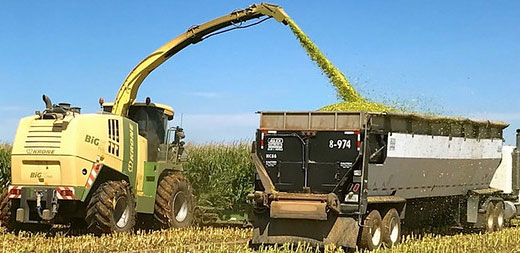
Keeping safety top of mind is important during fast-paced silage harvest operations.| Download this photo.
K-State beef specialist urges safety during silage operations
Heavy equipment, speed and long hours can be a dangerous combination
August 4, 2020
GARDEN CITY, Kan. – As silage harvest operations begin ramping up across the state, a K-State Research and Extension beef cattle specialist encourages farmers and feed yards to keep safety top of mind … and to remind others involved to do the same.
“As we look at silage operations, that’s one of the most fast-paced operations we participate in all year,” said Justin Waggoner, who is based at the K-State Southwest Research-Extension Center in Garden City. “We’ve got cutters and choppers in the field, we’ve got multiple trucks running up and down the road from the field to the pile or bunker, (and) we’ve got two or three pack tractors working.”
Listen to an interview with Justin Waggoner on Agriculture Today, with Eric Atkinson
Combining heavy equipment with speed and long hours makes harvesting and putting up silage a time ripe for an accident, Waggoner said. Plus, if it’s a custom crew hired to do the job, they may not be familiar with the farm or even the area.
“Repetitive operations tend to keep people from being aware of the situation around them,” he said, noting that the monotony of silage harvest can result in complacency, but urged those involved to practice situational awareness.
Fatigue, cell phone use and other distractions can also be problematic.
Waggoner said that this time of year when trucks are going up and down roads and crops are tall, visibility is sometimes limited, noting that some accidents are tied back to silage harvest operations.
“You don’t want to be one of the feed yards that gets the call from your neighbor down the road who says, ‘hey, those silage trucks are just zipping past the stop sign,’” he said.
Often there are people on foot working around silage piles or bunkers. If that’s the case, make drivers aware of that and encourage those on foot to wear safety vests for greater visibility.
Waggoner also warned against piling silage over and above the wall in a bunker.
“As a nutritionist, silage piled above the wall doesn’t get packed very well, so it doesn’t make good silage,” he said. “Plus, the edge of on overfilled bunker increases the chance of rollover when packing and is more prone to collapse. So from a safety and quality perspective, it’s best not to overfill bunkers.”
Finally, he discourages piling silage too high in drive-over piles, noting that if too high, the tops are inaccessible to equipment. In those cases, consider a second pile.
A radio interview with Waggoner on this topic is available on Agriculture Today, https://agtodayksu.libsyn.com/confined-cow-herd-feeding-silage-harvest-safety.
More resources related to safe silage operations are available at the Keith Bolsen Silage Safety Foundation or silagesafety.org. The foundation was started by the late Kansas State University professor Keith Bolsen and his wife, Ruthie, to promote safety during silage operations.

